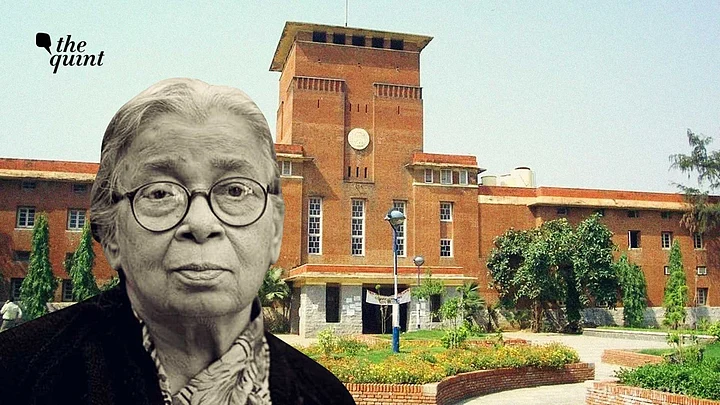Amid vehement dissent from stakeholders, the University of Delhi on Tuesday, 24 August, axed Bengali scholar Mahasweta Devi’s revolutionary short story 'Draupadi' from its BA English Honours syllabus.
The decision to drop the feminist, subversive story from the Women's Writing course has met with widespread opposition from scholars within the DU’s Academic Council as well as others, some of whom have called the move as being ‘casteist,’ ‘arbitrary,’ and ‘stifling.’
The celebrated short story, which narrates the tale of a tribal woman’s self-empowerment in the face of a debilitating patriarchal State, is widely hailed as Padma Shri awardee Mahasweta Devi’s tour de force.
While 'Draupadi' may have been dropped from the DU’s curriculum, it continues to hold great relevance in contemporary times. Here are five themes that make it an enduring tale for today's feminists.
1. Rape as an Instrument of Political Power
The story, written in 1978, is driven by an 'untouchable,' tribal protagonist Dopdi Mejhen, who is involved in a Naxalbari uprising of peasants in West Bengal. Dopdi, when she is nabbed by the police, is subjected to a series of rapes in the police custody. The bodily punishment inflicted upon her by those in power becomes a symbol of the patriarchal State’s tactics to suppress the agency and activism practised by a subaltern woman.
Devi further draws a relation between Pandava queen Draupadi, whose body was desecrated in the Mahabharata as an assertion of political victory, and her successor and namesake, Dopdi, who, centuries later, suffers a similar fate.
In the times when women dissenters are subjected to threats of sexual violation and crudity on a daily basis, the rape of Dopdi echoes the dominant regime’s continuing attempts at curbing women’s agency.
2. Systemic Oppression of the Adivasi Community
The leading of an operation for the forceful occupation of ‘upper-caste wells and tube-wells’ by the 'untouchables' becomes the crime for which Dopdi and her husband are sought by the police in Devi’s story. The police arbitrarily open fire at the tribals and kill several in the process of hunting those involved in the annexation of the wells.
On the other hand, the upper-caste landowners’ denial of water to the 'untouchable' community during the drought, the antecedent which has impelled Dopdi’s ‘crime’, does not find mention on the police’s charge sheet.
“By the Indian Constitution, all human beings, regardless of caste or creed, are sacred. Still, accidents like these do happen,” Devi tartly remarks in the story (emphasis mine).
The denial of water to those relegated to the lower rungs of the social hierarchy remains a concern even today. As recently as 2019, The Wire had reported that members of the Dalit community in Uttar Pradesh's Chitrakoot, if they approached the hand pumps of the village, were intimidated and threatened by upper caste villagers.
In 2017, an upper caste man of Karnataka's Kalaburgi had poisoned the village well in order to prevent Dalits from drawing water from it, Times of India had reported.
3. The Double Jeopardy of Being an Adivasi Woman
In Devi’s short story, Dopdi Mejhen and her husband, Dulna Majhi, are held as the ‘chief instigators’ of the tribal insurgency by the police. Even as they are accused of the same offence, the two are meted out different punishments.
While Dulna Majhi is killed upon capture, Dopdi is subjected to additional penalties of rape and torture, which are exclusively reserved for women.
The double deficit of caste and gender status therefore renders the Adivasi woman vulnerable to a greater trial. This remains the reality for women of 'lower-castes' in India even today.
An NCRB report released in October 2020 indicated that crimes against women have risen by 7.3 percent as compared to the previous year, while those against the Scheduled Castes and Scheduled Tribes rose by 7 percent and 26 percent, respectively.
Recently, a nine-year-old Dalit girl was allegedly raped, murdered, and hurriedly cremated by a priest and three other men in Delhi’s Nangal.
4. The Politics of the Subaltern Identity
Dopdi, the namesake of Draupadi, had been given her name by her mother’s mistress. That the identity of the Adivasi woman is imposed upon her by a member of the upper caste brings out how the underprivileged are denied any agency in the matter of their social categorisation.
Moreover, Devi’s pointed modification of the Sanskritic title of ‘Draupadi’ to fashion the name ‘Dopdi’ for her protagonist suggests that even as Dopdi’s experience is akin to her namesake, the tribal woman cannot lay claim to the same identity status as that of an upper-caste queen.
5. Woman As Her Own Saviour
At the end of the story, Dopdi, battered and ravaged, refuses for her body to be used as the State’s instrument for her shame. Instead, she walks, naked and tall, towards the police officer, Senanayak, who had ordered her rape, forcing him to confront the picture of his brutality.
Unlike her legendary namesake Draupadi, who had been granted divine, and notably, male, intervention at the time of her assault, Dopdi uses the inherent power of her feminine body to fight her battles.
“Draupadi pushes Senanayak with her two mangled breasts, and for the first time Senanayak is afraid to stand before an unarmed target, terribly afraid,” ends Devi’s story.
